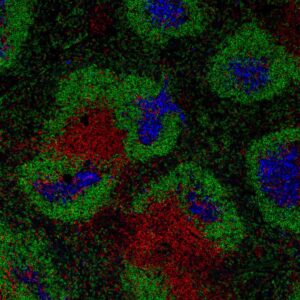More than ever, we are being bombarded with information about our body’s natural ability to fight infections. In the past few months, concepts such as herd immunity, antibodies and immunological memory, to name a few, have been slowly added to our vocabulary.
Although our curiosity about understanding how exactly our body is able to fight infections has peaked, this high volume of new information can be very intimidating. Many times, scientific concepts are explained using complex and inaccessible language, making them sound way more complicated than they should. With that in mind, I decided to start my first blog post by presenting to you an overview of our natural internal fighters, also known as the immune system. Each week, I will write about a new immunology concept, trying my best to keep it as easy as possible while being true to our current knowledge about this science.

Scanning electron microscopy showing two types of immune cells interacting. Dendritic cells are pseudo-colored in green and T cells are pseudo-colored in pink. Picture from the National Cancer Institute’s (NCI) Visuals Online.
Ok, so how does it work?
Think about the last time you watched a war movie. You probably remember the frontline soldiers. But you also know that behind these soldiers there are many different military personnel, each in charge of a specialized function. If you think about the air force, the pilots can patrol large areas, but they are also able to focus on high-risk sectors. Information during the war is another crucial aspect. Figuring out exactly where the conflict is and delivering this information to the chain of command for the dispatch of skilled soldiers to the area is essential. The coolest thing is, that a similar highly organized operational procedure is happening inside our bodies.
Imagine for a second the number of microorganisms (such as bacteria and viruses) you encounter every single day. I can assure you that your phone (or computer, if that is where you are reading this) right now, is full of them. But the nice thing is that we don’t need to worry about this every time we touch a surface (at least during normal times, and not pandemic times), and that is because our immune system takes care of most of them. A combination of patrolling cells, specialized cells, as well as cells present at “high-risk zone”, help us fight every single danger we encounter every day.
Can you give me a specific location?
I know, I have been talking about the immune system and it might very vague without a specific location. When we talk about the cardiovascular system, for example, you probably think about the heart, the blood and the blood vessels. But this question gets hazier when we talk about the immune system. The reason is that this system is composed of many different organs and cells which are connected through a network spanning almost all areas of our bodies.
We will start with the two key organs composing our immune system, which are also known as primary lymphoid organs: the thymus (which spoiler alert, is my FAVORITE organ of all) and the bone marrow. The thymus is an organ located just on top of our heart and the bone marrow is the tissue located inside our bones. I don’t know about you, but I don’t hear a lot of people talking about the thymus (although they should) or the bone marrow, as much as they talk about other organs. But these two are crucial for the generation of our immune cells.
There is also a combination of other organs, and organ regions, which are part of the immune system as well. These are known as secondary lymphoid organs. The spleen, lymph nodes, as well as areas underlining our mucosa tissues (which is a layer of tissue present on the surface of internal organs, such as the gut), are a few examples. It is quite straightforward to see why we would need our immune system in mucosal areas. These are “high-risk” areas since they are “open” to the outside environment (think about your food coming from the outside and passing through your gastrointestinal tract) increasing the chances of encountering external microorganisms.
Since our immune system is not composed of one, but many different organs and locations, it can sometimes feel overwhelming to understand it. But the beautiful way this network is orchestrated is what makes this science so amazing. It is ok if you don’t see this beauty yet, I promise I won’t stop talking about it anytime soon.
From your immunologist – in training,
Stefanie Valbon



